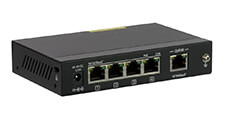Uplink Port
An uplink port is a port on a router or switch designed to connect to another router or switch or an Internet access device. Most home routers include an uplink port for connecting a cable or DSL modem.
An uplink port looks like a standard Ethernet port, which is a female jack for an RJ45 connector. However, there are two primary differences between the uplink port and other ports on a router or switch:
- The uplink port reverses the transmit and receive connectors.
- The uplink port may support more bandwidth than the other Ethernet ports.
Connector Reversal
When you connect a desktop computer or laptop to a standard port on a router, the Transmit pins from the Ethernet cable connect directly to the Receive pins inside the port. This is known as a "straight-through" connection since the data simply passes through the router. Similarly, the Transmit pins inside the port connect directly to the Receive pins on the connected Ethernet cable.
When attaching a router to a cable modem, switch, or another router, the Receive and Transmit terminals must be altered to function correctly. One option is to use a "crossover cable," which reverses four of the eight wires. Another option is to use an uplink port, which does this automatically.
Greater Bandwidth
Many routers and switches provide extra bandwidth through the uplink port to avoid data congestion. For example, a router may have four 1 Gbps Ethernet ports and one 2.5 Gbps uplink port. A switch may have sixteen 1 Gbps Ethernet ports and one 10 Gbps uplink port.
Since all incoming and outgoing traffic flows through the uplink port, it is important that it provides more bandwidth than the rest of the individual ports. Standard ports rarely use 100% of their maximum bandwidth at the same time, so the uplink port bandwidth is usually less than the combined bandwidth of the rest of the ports.
Using the Uplink Port
Most modern routers have an uplink port on the back. This port is often labeled "Internet" or has a circle icon that indicates it should connect to an Internet device, such as a cable or DSL modem. On switches, the uplink port is often labeled "Uplink" since it often connects to another switch or router.
NOTE: Some routers support "Auto-MDIX," which detects if a connection is straight-through or crossover. You can connect a modem to an Auto-MDIX port without a crossover cable, but it may not provide the extra bandwidth of an uplink port.
 Test Your Knowledge
Test Your Knowledge